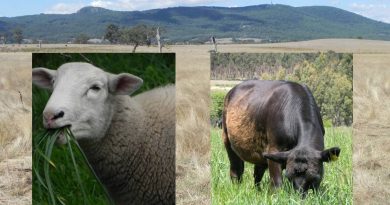Sustainable Intensification of agriculture – for food and nutritional security
By Professor Tim Reeves – awarded the 2019 Farrer Medal for “distinguished service in agricultural science in Australia.”
I have spent over 50 years of my working life pursuing ‘agricultural sustainability’ and have witnessed many changes, challenges and successes – both nationally and globally. The successes have resulted from the combined efforts of scientists and farmers working together to identify, develop and adapt new technologies and systems to both address continuing challenges to productivity and profitability, and to also seize the new opportunities that continually arise. The clear message for me is that agricultural sustainability is a ‘moving target’ and that no single system has remained sustainable for one reason or another, and nor will it in the future.
It is equally clear to me that a new ‘revolution’ of diversified farming based on the effective integration of crops, pastures, livestock, shrubs and trees together with diverse practices, is urgently required to make farms more resilient financially, and to the increasing challenges of climate change and climate extremes. To achieve this resilience, it is also an imperative to build soil carbon content and soil health generally. The new ‘sustainability mantra’ worldwide is based on the ‘sustainable intensification’ of farming systems and more recently on ‘regenerative agriculture’ for the whole agri-food value chain. In this Farrer Memorial Oration, I consider the challenges and opportunities of sustainable intensification as a pathway to continue William Farrer’s ideals of ‘aiming high and making an impact’.
The ‘Grand Challenges for Agriculture’
In my Donald Oration (Reeves 2017b) I described the five ‘grand challenges’ that agriculture faces as it seeks to satisfy the needs of future food and nutritional security. Those challenges have not changed – nor would one expect them to in such a short period of time – but I have refined them to reflect further thinking and recent developments in knowledge and events.
In addition, it is now vitally important to view these challenges in the stark context of ‘nutritional security’ as well as food security. Malnutrition in its wider definition is rampant and negatively impacting livelihoods in the vast majority of countries, including Australia, figure 1. Much needs to be done if we are to sustainably produce not just more food, but more, more nutritious food to meet humankind’s needs.
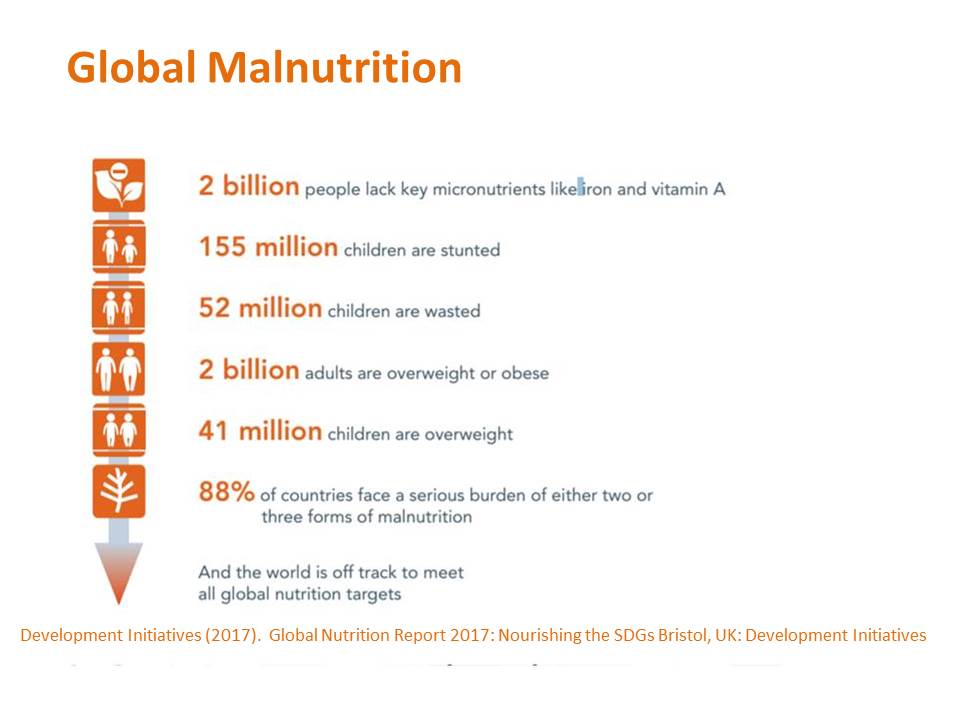
Figure 1 – The different types and incidences of global malnutrition
These are the ‘grand challenges’ I have developed, based on my own experiences and in consultation with learned colleagues.
1. GRAND CHALLENGE (GC) – LOSS AND DEGRADATION OF NATURAL RESOURCES (Land, Water, Air)
Prime agricultural land is being lost at an alarming rate around the world. Depending on which source of data one uses, the range of losses is from around 1 to 7 million hectares/year (various sources). As a result of population increase and land losses, the area of arable land per capita has decreased from almost 0.35ha/person when I started my career as an agronomist, to less than 0.2 ha/person now (World Development Indicators and World Population Statistics).
In addition, of the land remaining in agriculture, much is degraded, some severely, resulting in lowered productivity (FAO 2015). More people, more food and more nutritious food required, but less land on which to produce it. This is a major challenge in its own right. Giving much greater emphasis to enhanced soil health and better soil fertility in the lands remaining, is therefore of paramount importance.
At least 70% of global freshwater withdrawals are used for agriculture (OECD 2017), with around 45% of global cereal crop production coming from irrigated systems. However, the irrigation efficiency of some of these systems is less than 50%. There has also been a rapid increase in competition for water resources between agriculture and other uses including for urban, industrial and environmental purposes and this competition will only be exacerbated in coming years.
On current trends, global blue water withdrawals would approximately double by 2050 compared to 2000 levels. With ‘business as usual’ this additional water would simply not be available. Water stress will increase in many agricultural areas by 2025 due to growing water use and higher temperatures (IPCC Scenario A1B). Agriculture must not only increase water-use efficiency but also reduce overall water consumption – a major challenge.
Lastly, in relation to natural resources, greenhouse gas (GHG) emissions from agriculture are a major issue. It is estimated that around 14.5% of current global GHG emissions come directly from agriculture (Gerber et al 2013), with a further 10% arising from land-use changes including deforestation. If food production is to be doubled by around 2060 and current production methods are used, then it is estimated that this figure could rise to over 50% of global GHG emissions, a clearly unsustainable scenario. GHG emissions from agriculture must therefore be mitigated and reduced if the social license to farm is to be maintained.
Natural Resources – what needs to be done?
• Development of integrated policy frameworks across the water-agriculture-food-energy-environment-population nexus
• Increased WUE and reduced water consumption
• Clear policies and strategies for peri-urban and urban agri-food production and associated land use planning
• Increased emphasis on soil health and fertility including ‘tipping points’
• Conservation agriculture and sustainable intensification essential
• Farm enterprise choices based on input-use efficiencies
• Mitigation of GHG emissions by use of Best Management Practices (BMP) to avoid future ‘right to farm’ challenges.
2. GRAND CHALLENGE – ADAPTATION TO CLIMATE CHANGE
In February 2015, the Director General of FAO made the following headline statement “The impacts of climate change are no longer an anticipated threat.” This seemed to be a pretty bold statement if one did not read on. His full statement was: “The impacts of climate change are no longer an anticipated threat. They are now a crystal-clear reality right before our eyes. Climate change will not only affect food production but also the availability of food and the stability of supplies. And in a global, interdependent economy, climate change makes the global market for agricultural products less predictable and more volatile.”
There is no doubt that if the world is to achieve global food and nutritional security, adaptation of our farming systems to climate change is absolutely critical. Climate-smart agriculture is required, and sustainable intensification can help us deliver more adaptive and more resilient production systems.
Most studies project net adverse impacts on crop yields due to climate change, and many of those adverse effects will be felt in regions that are at the forefront of both food production and food consumption, including South Asia; West Asia and North Africa; parts of East Asia; major areas of Sub-Saharan Africa; and large areas of South America (World Bank 2010).
These impacts have been confirmed from some of my own experiences working in these regions over the past couple of decades. For example, in a review that I chaired for FAO and the Government of India in 2009, on the impacts of climate change on Indian wheat production, farmers in NW India told us that the water level in their tube wells was falling by from 1 to 2 m per year, well above the overall NASA monitoring assessments of around 0.4 m per year – substantial in itself.
These unsustainable water reductions were considered to have resulted from over-use of water as a consequence of two factors, the first was perverse policy settings that provided substantial subsidies for the costs of pumping water. The second factor was the changing climate whereby some aquifers were no longer being adequately replenished during the annual monsoon season (FAO 2009).
Most of the indicators for climate change in Australia paint an equally concerning scenario (Alexander et al. 2017). These include the following – annual average temperature increases, with 2018 being Australia’s warmest winter on record, an occurrence that the Climate Council reports was 60 times more likely to have been caused by climate change; greater climate variability – although a recent article disputes this (Freebairn 2017); a higher incidence of extreme events – more likely to have occurred due to climate change (Graham and Eckard 2017); and reduced run-off in many regions (BOM 2016).
The paper published by Dr Zvi Hochman and colleagues “Climate trends account for stalled wheat yields in Australia since 1990” (Hochman et al.2017), is perhaps a clarion call for more emphasis on adaptation to climate change and that ‘business as usual’ will not be viable. On the positive side, the authors pointed out that whilst wheat yield potential had decreased by 26% over the study period, actual yields had generally not fallen so markedly, as technology gains – read ‘adaptation’ – had been able to offset the potential losses.
The question remains as to whether the future rate of technology gains can keep pace with the impacts of a changing climate, where much of the Australian cropping regions are likely to get warmer and dryer. Greater, longer-term and patient research investment is urgently needed to maintain and hopefully increase, the rates of adaptation in all major crop and forage farming systems.
Adaptation to climate change – what needs to be done?
• National adaptation strategies for agriculture where all innovation is evaluated through the ‘lens’ of climate change
• Substantial, long-term, patient co-investment in adaptation and mitigation by public and private sectors
• Farming systems that are more diverse, more resilient and adaptable and less emissive, based on sustainable intensification
• Infrastructure that both helps adaptation and is itself adapted to climate change
3. GRAND CHALLENGE – NITROGEN USE (IN)EFFICIENCY
Nitrogen fertilisers account for over 50% of the protein in human diets and are therefore critical to global food and nutritional security. However, the ‘elephant in the room’ for these fertilisers is that nitrogen-use efficiency (NUE) only averages around 50% and the economic and environmental costs of low NUE are substantial and unsustainable (The Conversation 2016). Already, some countries and regions are basing ‘right to farm’ challenges on environmental damage caused by losses of nitrogen from farming systems (e.g. Dairy NZ 2014).
Global nitrogen fertiliser use has increased at a rate much greater than population growth and this dependence on N fertilisers has often been accompanied by less use of biologically fixed nitrogen from legumes. Legume-based cropping systems have been shown to reduce carbon and nitrogen losses in many situations (e.g. Drinkwater et al. 1998; Migliorati et al. 2015).
I believe that we need to urgently review our investments in legumes, in order to re-invigorate their usage on farms. Here in Australia, we have conclusive evidence around the importance of pulses and forage legumes in our farming systems (e.g. Peoples et al. 2013; Seymour et al. 2012) but their uptake remains static. This also needs to be addressed and the reasons – particularly the factors influencing farmer decision-making – investigated, so that new and effective strategies can be implemented.
Legumes in global and local farming systems can have major beneficial impacts on food and nutritional security; on more diverse and resilient farming systems; and on reducing nitrogen losses and environmental impacts.
Of particular concern globally, is that nitrogen-use efficiency has reduced substantially since the 1960s (Tilman et al. 2002). As a result, these increasing losses have not only resulted in economic losses on farms but have also contributed to the “Nitrogen Cascade” and resultant environmental damage described by Professor Galloway during his visit to Melbourne in 2016 (Galloway et al. 2016).
In Australia, due to our high consumption of animal products, we have one of the world’s largest per capita ‘nitrogen footprints’ – around 47 kg N /person (c.f. 28 kg N/person in the US) another indicator that ‘business as usual’ is not sustainable (The Conversation 2016).
A lesser concern expressed around nitrogen fertilisers, but still of significance, is that urea the most widely used form globally, is a product that requires the use of ‘fossil fuel’ – natural gas – in its manufacture. Given the needs to reduce GHG emissions from the sector this could be seen as counter-productive and raises the question as to the development of other forms of N fertilisers that are not based on ‘fossil fuels’ (IAASTD 2016).
We know that there is plenty of work on reducing dependency on fossil fuels in the energy, automobile and housing industries but is there any progress with regards to alternative processes for N fertiliser production?
Nitrogen efficiency – what needs to be done?
• Greater investment in energy-efficient fertilisers and better technologies
• Re-invigoration and re-investment in legumes RDE emphasising sustainability
• Real-time testing for mineralised soil nitrogen
• Enhanced Best Management Practices (BMP) for N use
• Regulatory framework for N use based on BMP
• Community education around our ‘N footprint’
4. GRAND CHALLENGE – FOOD LOSS AND WASTE
FAO has estimated that of the food produced globally, 32% by weight and 24% by calories, is lost or wasted! (FAO 2011b). This does not make economic or environmental sense – in fact, the complete opposite – and if we could reduce the rate of food loss and waste it would not only have substantial beneficial impacts on global food and nutritional security, but also on important sustainability issues.
This is an area that provides both huge challenges and huge opportunities for improvement. For this paper, food losses are considered to be pre-farm gate and food waste, post-farm gate including consumption.
Unsurprisingly, the extent and the sources of food loss and waste vary around the world and Figure 2 illustrates this well. Of significant concern is the high proportion of food losses at the farm level in Sub-Saharan Africa, arising from problems with production and storage and handling.
There must be even greater investment by the international community in overcoming these problems. However, levels of per capita food loss and waste are higher in Europe and Industrialised Asia, whilst North America and Oceania have the highest per capita food loss and waste by a significant margin, with around 60% of that occurring at the consumption level, an alarming and disturbing fact.
There are a number of factors that I believe are influencing and exacerbating the profligate and unsustainable levels of wastage in Oceania and North America. Taking Australia as an example, conservative use-by dates and ‘over–the-top’ specifications for products in supermarkets are both significant contributors. Both result in unnecessary rejection of products and resultant wastage.
However, my main hypothesis is that a major underlying cause of our extreme levels of wastage, arises because many of us in the Western world have lost our respect for food, treating it as a commodity that will always be there and that we can take as much of as we wish, regardless of cost or real needs (Reeves 2017a). Such an attitude – which is in sharp contrast to the great respect for food in most developing countries – results in over-purchasing, excessive portion sizes for meals and in many cases over-consumption.
When we phone up the pizza shop with our order and they say ‘We can give you two for the price of one’, there are many of us who should say ‘Why?’ rather than ‘Why not?’…
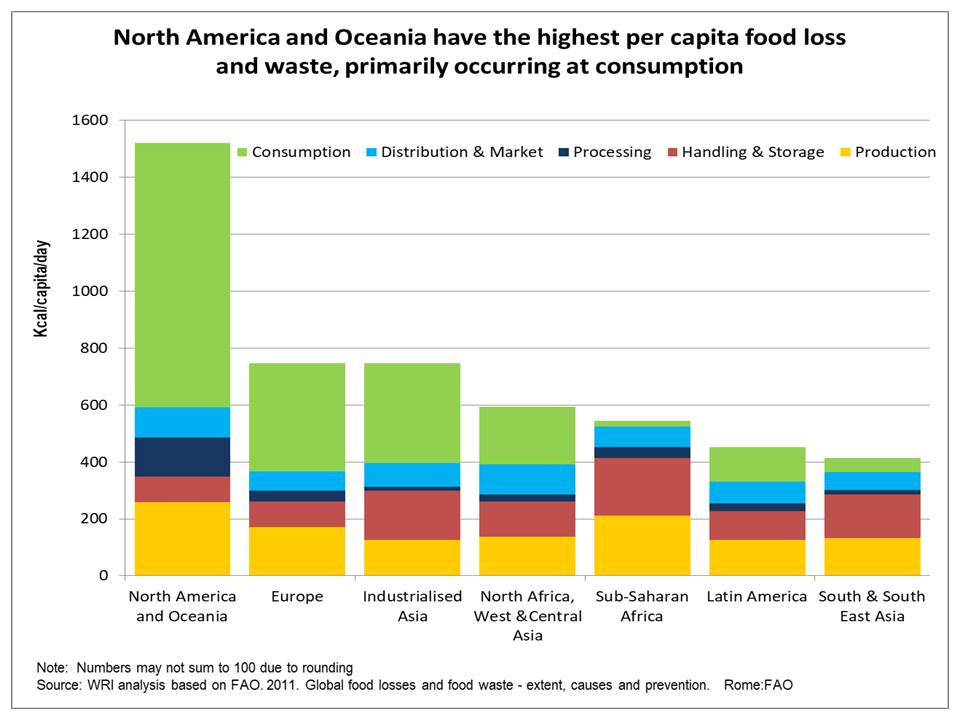
Figure 2. Variation in food loss and waste from various stages of food production and consumption around the world.
Dietary choice can also have an important part to play in food loss and waste and the sustainability of farming systems. The following are some examples drawn from the literature:
• If the rate of food wastage is reduced by 50% by 2050 – the ‘food gap’ would be reduced by 22% (Lipinski et al. 2013)
• If all consumers were vegetarians and ate to nutritional guidelines it would reduce global nitrogen usage by 50% (Galloway et al.2016)
• The average daily (embedded) water consumption of a meat-eating person is twice that of a vegetarian (www.angelamorelli.com/water)
Food loss and waste – what needs to be done?
• Value-chain nexus approaches to reducing loss and waste
• Setting food loss and waste reduction targets to drive strategy
• Investment in RDE to reduce pre- and post-harvest losses for smallholder farmers
• Increased food re-cycling/’second harvest’ approaches and less conservative use-by dates (industrialised countries)
• Respect for food – education around purchasing, portion sizes and consumption (industrialised countries)
5. GRAND CHALLENGE – (Benign) NEGLECT AND EROSION OF RURAL COMMUNITIES
This is a major global issue that is already having significant implications for food and nutritional security. It is estimated that 70% of the world’s population will be urbanised by 2050 and that figure already stands around 50%, including in some developing countries. This rapid urbanisation of communities poses some key policy dilemmas for government decision-makers.
Not the least of these is the ongoing tension between affordable food costs for city-dwellers and high enough prices for farm products, that allow farmers to make a profit and stay in the business of food production. It is common to hear politicians refer to their determination to keep food affordable, but it is much less common to hear them espouse similar determination to keep farms profitable. The achievement of both is absolutely critical to future food and nutritional security.
One of the main reasons for the migration from rural areas to the cities in many countries – both developing and industrialised – is the steady erosion of infrastructure and essential services in rural areas, leading to continual rural restructuring and demographic changes. This is not a new phenomenon and the outstanding social researcher Neil Barr, has stated that in the average lifetime of an Australian farmer s/he can expect the number of local farms to halve in number (Barr 2009).
In addition, there is a range of other socio-economic issues that disproportionately affect rural communities. Alston (2011) lists some of these:
• High levels of rural poverty
• Out-migration
• Masculinisation of remote communities
• Higher unemployment
• Poorer health
• Lower levels of education
• Higher levels of ageing
• Poorer service infrastructure
I have talked to some long-standing friends who still live in rural areas in Australia and their thoughts reflect many of the points made by Professor Alston. They add additional concerns around health and safety – particularly around increased illicit drug usage; the demise of social and sporting clubs due to population decreases; and the ICT ‘divide’ between connectivity in metropolitan and rural areas.
I have other friends who run a large farming business, but who cannot get mobile phone reception or internet access at their home. Their home is not ‘beyond the black stump’ but less than 300 km from Melbourne! Would a business in Melbourne tolerate such poor services? We all know the answer – a resounding ‘NO!’. But if you live in the country, all too often this is the type of issue that is commonplace. Technological changes and climate change have added to the uncertainties facing rural communities.
These principles and deficiencies are common to both developing countries – where some of these problems can be even more severe – and industrialised countries. Future food and nutritional security will only be achieved if farmers can access the services and infrastructure that they require to remain productive, profitable and sustainable. Governments and other key decision-makers must address these issues with urgency!
Rural communities – what needs to be done?
• Development of a clear vision, strategy and investment plan for rural regions
• Cohesive and supportive policy framework
• Greater rural community participation in policy advice
• Immediate attention to assessing the impacts of technological changes and climate change
• Further decentralisation of government services to rural areas
Addressing the ‘Grand Challenges’ through Sustainable Intensification of Agri-Food Systems
What does ‘sustainable intensification’ mean? In simple terms it is about ‘doing more with less’ (Pretty 1997; Reeves 1998; Pretty and Bharucha 2014). Some have simplified it further to ‘more crop per drop’ but the two underlying principles are increased productivity/profitability, simultaneously achieved with enhanced ecosystem health.
But firstly, I wish to put this important development into the context of where we have come from, as it’s important to understand this to successfully develop the ‘road map’ for where sustainable intensification can take us.
When I commenced my career at the Rutherglen Research Institute in NE Victoria in 1967, ley farming was at its peak and considered to be the ‘holy grail’ of sustainability. Soil fertility was built up under subterranean clover/annual grass pastures that were grazed by sheep and sometimes cattle, and after 3 to 5 years these were then ploughed up, cultivated several times and planted to wheat.
The soil fertility built up under those pastures was often sufficient for the production of 3 or 4 successive cereal crops, with the final crop – often oats – under sown with sub-clover to commence the next pasture/grazing phase (see Ellington et al 1979, later in this paper).
This ‘holy grail’ initially teetered for economic reasons – market returns from both sheep and beef cattle were extremely poor in the 1970s – and simultaneously bio-physical problems as soil acidification, compaction and cereal root diseases all took their toll.
This demise of ley farming was for many, one of the most significant and shocking examples of the ‘moving target’ of sustainability. There are lessons and principles arising from that demise that need to be taken into account when evaluating what is happening with our farming systems today.
Since those times, I have been a part of and/or witnessed two subsequent major changes in farming systems.
Firstly, the move after ley farming to more intensive cropping – using cereals, oilseeds and pulses – in both higher rainfall zones and in traditional grain producing regions, but still within a framework of mixed farming (perhaps the most sustainable system that I have seen, but more on that later).
Secondly, this progressed to even more intensive cropping based on zero till, dominated by canola-wheat rotations, with a very heavy reliance on fertilizer nitrogen applications and often the total removal of livestock from farms. It is these intensive cropping systems that are now, in my opinion, moving steadily towards being unsustainable, with new climatic risks exacerbating the abiotic and biotic risk factors, and the resultant economic risks associated with such narrowly based farming systems.
Globally, and increasingly nationally, sustainable intensification is seen as the way forward to achieve the ‘win-wins’ of productivity, profitability and environmental sustainability. The Oxford Martin Programme on the Future of Food, at the UK’s prestigious Oxford University defined it as follows:
The goal of sustainable intensification is to increase food production from existing farmland while minimising pressure on the environment. It is a response to the challenges of increasing demand for food from a growing global population, in a world where land, water, energy and other inputs are in short supply, overexploited and used unsustainably. Any efforts to ‘intensify’ food production must be matched by a concerted focus on making it ‘sustainable.’ Failing to do so will undermine our capacity to continue producing food in the future.
This a challenge, but one that it is essential to overcome, as we must produce more to meet ever-growing global demand – world population is still growing at around 140 people per minute, all of whom need access to sufficient nutritious and safe food to live healthy and productive lives. In so doing, we have to ensure that key environmental factors – soils, water, air and other key attributes – are enhanced, so that our children, grandchildren and their successors can continue to meet the future demands for food and nutritional security, as they will have to achieve it from less land, with less water, less energy-rich inputs, less greenhouse gas emissions and under the potential ‘multiplier effects’ of climate change and greater climate variability.
Many of our current farming systems do not satisfy these sustainability criteria. The essential foundations are, as previously noted, the simultaneous achievement of increased productivity/profitability AND enhanced ecosystem health.
In considering this, my friend and distinguished colleague Professor Amir Kassam a global leader in conservation agriculture, illustrated how sustainable intensification farming system practices can contribute to important ecosystem services (Friedrich et al 2009). Their findings are shown in table 1 and one can see the major commonalities with other forms of regenerative agriculture (for example, WA Landcare 2019).
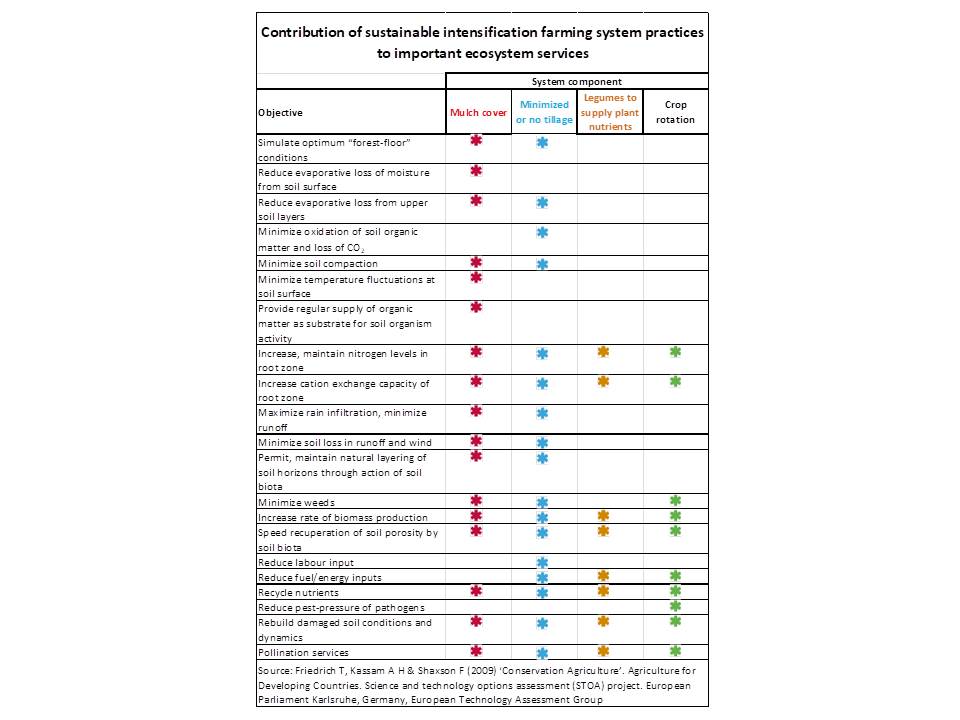
Table 1 Sustainable intensification and ecosystem services (FAO 2011)
In order to implement sustainable intensification at the farm level, there are five key building blocks (adapted from Reeves et al 2016). Each is important in its own right, but the greatest impacts arise from their effective combination and integration. These building blocks are:
• Conservation agriculture (CA), through minimal soil disturbance (zero tillage), the use of surface mulches and crop rotation and the integrated production of crops, forages, livestock, trees and shrubs
• Healthy soils with greater levels of soil organic matter, through integrated soil nutrition management including more legumes, to enhance crop growth, bolster stress tolerance and promote higher input use-efficiency of water and nutrients
• Improved crops/varieties/livestock that are well adapted, with high yield potential, resistance to biotic and abiotic stresses, more input-use efficient and with higher nutritional quality
• Efficient water management (after ensuring environmental flows are met) that improves productivity, labour and energy efficiency, helps reduce agricultural water pollution and ultimately uses less water
• Integrated pest management based on good farming practices, more resistant varieties, natural enemies and judicious use of pesticides when necessary.
Some would argue that Australian farmers are already well invested in these five practices, and certainly in terms of some elements of component one – CA – this is true, as we are a leader in the adoption and adaptation of conservation agriculture. However, there are still some very important areas where changes and improvements have to be made and these are addressed in the sections that follow.
Enhancing Sustainable Intensification Practices – in Australia and Globally
Conservation Agriculture
Australia has been and remains a leader in the development, adaptation and adoption of CA systems (NLA Trove 2016; D’Emden et al 2008). These achievements have been the result of a number of effective partnerships – between scientists and farmers; between the public and private sectors; and between farmers, through grower groups including the No-Till Farmers Associations. However, there are clear signs that new and different directions need to be taken if CA is going to continue effectively contributing to sustainable intensification, both nationally and globally.
In Australia, greater system diversification is required. Canola-wheat rotations, which now dominate southern cropping farms are not a diverse system. In addition, nitrogen use efficiency still averages around 50% with the application of nitrogen fertilizers, and some of these losses are contributing to emissions of the potent greenhouse gas, nitrous oxide.
Recent research has shown that these losses can be reduced by the utilization of more biologically fixed N from legumes – both pastures and pulses – as legume-fixed N is generally a less emissive form of N input than fertilizer N (NANORP 2012-2015). Pasture rotations which help to re-build soil carbon levels and in so doing sequester carbon dioxide are absent from many farms and yet without them there is clear evidence that soil carbon/OM levels are steadily declining in our farming systems (see later under ‘Soil Health’).
Management options for greater, ‘modernized’ system diversification include:
• Improved soil management with minimal or no disturbance, surface and subsoil amendments where appropriate, with lime, gypsum, organic materials and major and macro-nutrients to stimulate soil biological activity and overall soil health
• Greater range of crop options – wheat, barley, oats, triticale, millets, sorghums, maize, canola and various pulses and other legume options
• More diverse crop varieties/species – range of planting times, flowering times and crop maturities, and with greater resistance to biotic stresses and tolerance of abiotic stresses (dryness, heat, frost)
• More diverse crop management – differential grazing/defoliation regimes, N timing and forms including more biologically fixed N, cover crops/mulches, differing stubble heights and spreading
• Livestock integration for enhanced crop, residue, weed and pasture management and N cycling and for diversification of farm income streams
• Incorporation of trees and shrubs to provide a range of ecosystem services, including shade and shelter for livestock, as the incidence and magnitude of heat stress for animals is likely to increase as our temperatures rise and more ‘high heat’ days are experienced. Re-invigoration of ‘adaptive agroforestry’
• More innovative ideas that will require more research and evaluation, could include; sowing ‘shandies’ of crop varieties; strip cropping – alternate strips, of say a cereal and a pulse, side by side across the paddock; inter-cropping – different crops in different rows; ‘fan’ drones to aid frost protection; biopolymers for soils to reduce evaporation (and perhaps one day, to protect crops). Too futuristic? So were smart phones around 15 years ago…
Angus et al (2015) have provided an excellent review of the impacts of break crops on wheat yields based on more than 900 comparisons conducted across Australia and elsewhere and it is well worth reading.
Healthy Soils
Soil health is defined as ‘the capacity of the soil to function as a living system that sustains plant and animal productivity, maintains or enhances water and air quality, and promotes plant and animal health’ (Doran and Zeiss 2000).
Soil health and fertility are the ‘engine room’ of productivity, profitability and sustainability on farms and yet there are some disturbing signs that our current intensive cropping systems are steadily depleting both soil N and soil carbon levels (figure 3) here in Australia (Sanderman et al, 2010; Sanderman and Baldock, 2010; Lake 2012b). These are critical indicators of sustainability for our farming systems as the benefits arising from fertile, healthy soils are well recorded and include – increased water infiltration; increased microbial activity and nutrient availability; enhanced root growth; less dependence on energy-rich inputs, particularly nitrogen fertilizers; and more resilient farming systems.
Declining N fertility – need for legumes…..
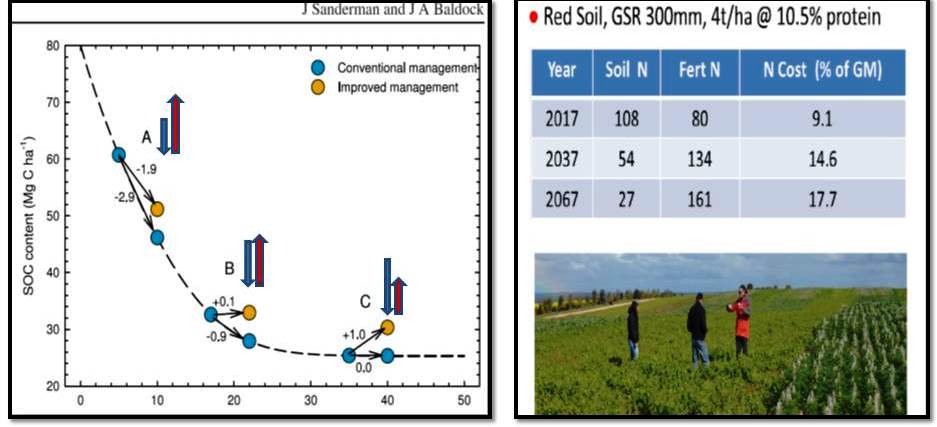
Figure 3 Soil C and N changes under current farming systems (Courtesy of Dr John Kirkegaard CSIRO)
In relation to soil carbon levels under intensive cropping, Dr Geoff Baldock, CSIRO (Baldock 2019) made the following salient points:
• Stocks of soil organic matter (SOM) and nitrogen (N) are limited resources and current trends across Australian agricultural soils indicate that these are declining (Luo et al. 2010).
• Soil derived N can contribute to the amount of N available to a crop. As the capacity of a soil to deliver N declines, increased rates of fertiliser N will be required and optimising profit (where marginal benefit=marginal cost) may move to lower yields.
• N balance calculations are essential to define how management is altering the stock of soil N. A range of indices exist that can be monitored over time to provide an indication of how management is affecting N stocks.
• Altering management practices to maintain SOM and N status are likely to be associated with increased costs (either increased expenditure or opportunity costs). Mechanisms for offsetting increased costs associated with applying management practices to accumulate organic matter and N exist, and more are under development.
• Taking a long term (decadal) view on the economic implications is critical to ensure future productivity will not be compromised in an effort to maximise short term (annual) profits.
In addressing the steady and relentless declines in soil N, figure 4, across our farming systems (Lake 2012b), (Peoples et al (2017) and Lake (2012a) have both described the importance of including more legumes in these intensified systems, with the greatest impacts on soil N accretion resulting from pasture legume phases or ‘brown manuring’ of grain legumes (see table 2).
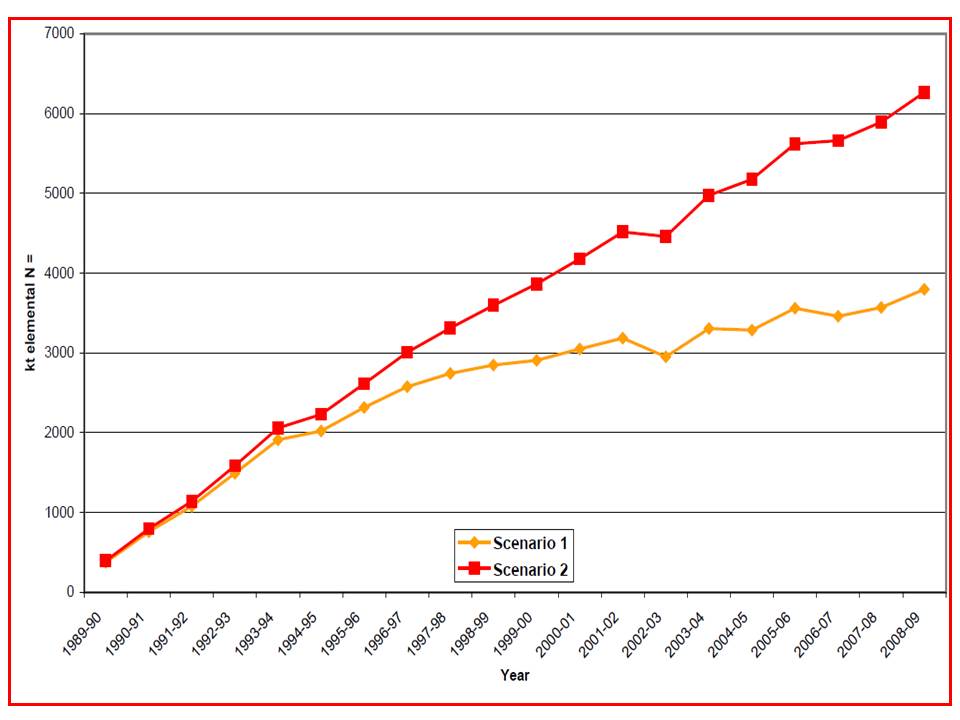
Figure 4 – Accumulated N deficits expressed as elemental N fertilizer equivalent in Australian temperate crop soils as estimated by two scenarios, Scenario 1 being the best possible case of N fertiliser usage on those crops and Scenario 2 being a more realistic assessment of likely N usage levels. Australia’s declining crop yield trends II: The role of nitrogen nutrition – A.W.H. Lake
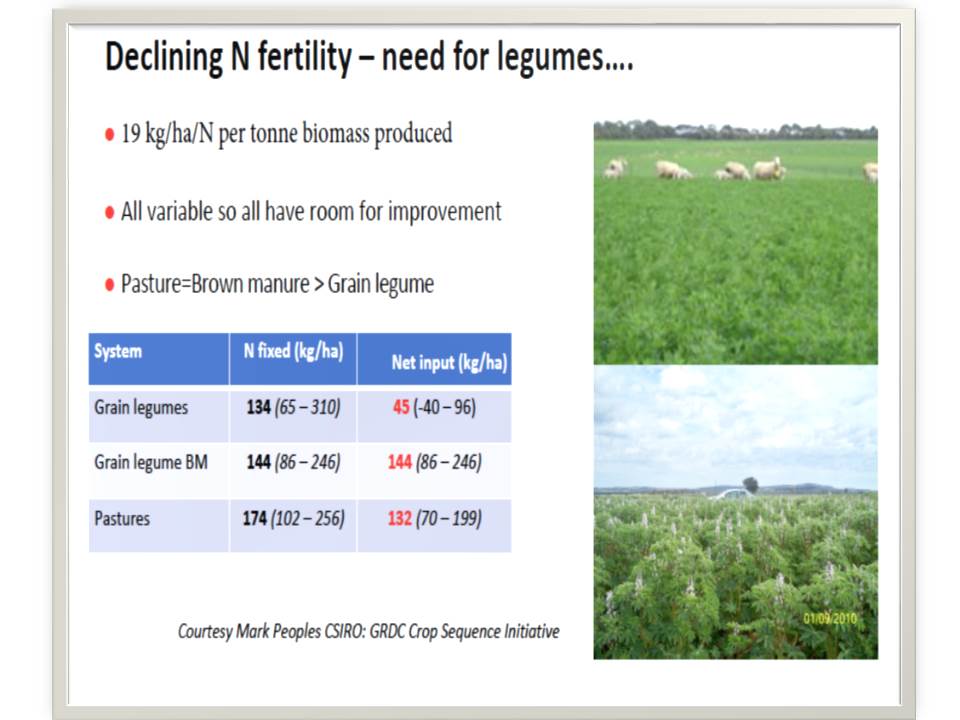
Table 2 – Impacts of legumes on soil N levels
In honouring the memory and work of William Farrer and his emphasis on soil fertility as well as crop breeding, it has stimulated me to look back at lessons from the past and in so doing to reflect on the outstanding work on soil fertility of my long-time, now sadly passed colleague, Tony Ellington.
His work at Rutherglen in the 1960s and 1970s, on soil N and OM accretion under clover pasture leys and its subsequent use by successive cereal crops reminds us that we have a number of well proven options to increase soil N, as Baldock (2019) re-affirms.
I have reproduced one of the original figures, figure 5, from Tony’s work (Ellington et al 1979) and it is interesting to note that the clover-ley system that he used actually resulted in a ‘spiralling up’ of soil N levels despite the growing of four successive wheat crops after the 5 year pasture phase. This is in contrast to the ‘spiralling down’ trend that we are now experiencing on many farms and one could argue that these steady losses of soil nitrogen and carbon levels could be interpreted as a slow path to financial demise where the largest impacts are likely to be endured by the next generation.
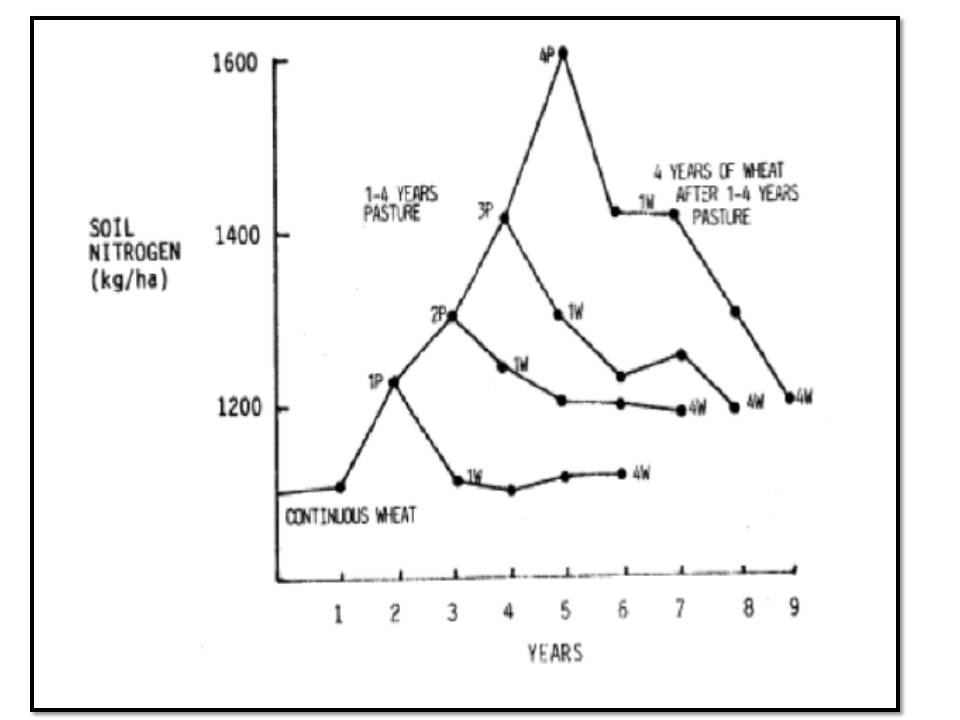
Figure 5: Soil N accretion under legume pastures (Ellington et al 1979)
Of course, as previously outlined, we know that the ley system broke down due to a number of biophysical and economic reasons. However, we now have ready solutions to these biophysical problems and the returns from livestock have well and truly risen.
There is evidence that in many regions, crop-livestock producers have fared better than crop-only producers during the tough seasons experienced in recent years, as livestock have been a source of economic diversity and have helped to offset climatic and market risks, as well as helping to enhance soil health.
Sustainable intensification and the future of farming is highly dependent on fertile, healthy soils and if we are to achieve the dual imperatives of enhanced productivity and ecosystem health then greater attention to our key resource, the soil, is urgently required. Many ancient civilisations declined as soil fertility declined – “Civilisations rise and fall on the quality of their soil” (Scholes and Scholes 2013) – let us not join them.
Improved crops and livestock
Improved crop varieties are invariably used in our current systems and are an important component of sustainable intensification, now and in the future. It is however critical that greater emphasis is given to those genetic attributes that will boost the success of sustainable intensification systems. These include the continuing development of durable resistance to biotic stresses, where good progress continues to be made (eg McIntosh and Pretorius 2011).
For other important crop traits, the development and adoption of early sown winter wheats (Hunt et al 2019) has been an exciting development and highly beneficial in helping many crop producers to adapt to changing climatic conditions, particularly the changed rainfall patterns of the past 25 years or so, where autumn and winter rainfall has declined and summer rainfall increased, in many parts of southern Australia (Karoly 2014).
However, the excellent work of Flohr et al (2018) is a reminder that constant attention is required to meet the changing needs of our evolving farming systems as she and her colleagues found that the rates of wheat yield increases in NSW had plateaued since the 1980s; that flowering time was less stable in the modern varieties; and that vernalisation could become a more important trait in our wheat breeding programs.
As perhaps a support to their conclusions that the rate of wheat yield increase had declined possibly due to an emphasis on quality related traits rather than yield per se, the performance of several imported feed quality wheats e.g. RGT Accroc (N. Poole, Hyper Yielding Cereal Project GRDC Updates 2018) has been quite remarkable in some regions. In a field comparison conducted at the University of Melbourne’s Dookie Campus in 2018, RGT Accroc yielded around 30% more than Australian bred grazing wheats, despite a very dry and hot growing season.
RGT Accroc is of French origin and this reminds us once more of the vision of William Farrer who had close collaboration with the French wheat breeder Henri Vilmorin, all of those years ago. France has proven to be an excellent source of high yielding wheats for many decades and it seems that the Farrer partnership with Vilmoren contributed to the foundations of this, as Vilmoren’s varieties featured strongly in Europe for a more than two decades – including some resulting from crosses with Farrer’s material (Belderok et al 2000).
Another important aspect of the use of a range of crop varieties for sustainable intensification and as a source of genetic diversity on farm, is the diversity between farms in a district or region. The genetic diversity between farms is often limited – for example a single canola variety dominated around 70 to 80% of the planted area in NE Victoria in 2018.
From an industry perspective this is undesirable in terms of risk management particularly for diseases, and adds complexity to the decision making by growers and their agronomists when selecting varieties. For sustainable intensification, decision making must move from paddock productivity, to system productivity, to farm productivity and the latter also needs to take into account the landscapes and ecosystems in which the farm is located.
Crop varieties/species with enhanced resistance/tolerance to abiotic and biotic stresses; with greater input-use efficiency – water, nutrients and elevated carbon dioxide; with greater adaptability to mixed farming systems – for example graze and grain crops; and with greater nutritional value, are all required as a key component of sustainable intensification.
Improved livestock are also a key part of sustainable intensification systems both globally and here in Australia, eg Herrero et al (2010) and McDermott et al (2010). In the Australian context we have long concentrated on successfully breeding and selecting for productivity gains – meat, wool, milk – for key management attributes – durable conformation, easy calving/lambing, temperament – and for quality aspects.
Whilst all of these remain important, there are now other traits to be considered that are critical to sustainable intensification systems and these include:
• Enhanced stress tolerance – especially, to heat
• Enhanced input-use efficiency – particularly feed conversion efficiency
• Enhanced pest and disease resistance – particularly to pathogens more likely to be important in a changing climate
• Adaptation to a range of ‘new’ farming systems – including housed and zero grazing options.
Genomic selection is helping to make all of these a reality and significant progress has been made in several of these areas. In the dairy industry (e.g. Pryce et al 2018; Nguyen et al 2017) provide good examples of this progress.
Efficient water management
Water use-efficiency on many Australian farms is high, but nationally crop yield gaps – between potential water limited yields and actual yields – average around 30 to 40% (Kirkegaard et al 2014) and so there is still significant scope for improvement, albeit with the need to take risk management into account.
In his 2017 Farrer Oration (now also published as Kirkegaard 2019), John Kirkegaard emphasised the need for an integrated approach to enhancing water-use efficiency, citing that the combined impacts of better varieties adapted to earlier sowing and improved agronomy are necessary to achieve these greater efficiencies (Kirkegaard and Hunt 2010). These are also the principles of sustainable intensification where system productivity and sustainability are the aims, rather than maximizing the performance of one crop or livestock unit.
An excellent example of system adaptation to achieve efficient water management is the widespread adoption of summer weed control in the rainfed cropping regions of southern Australia. As rainfall patterns have changed (Karoly 2014) with resultant reductions in autumn and winter rainfall, but in many cases also with marked increases in summer rainfall, the practices of conservation agriculture and summer weed control have helped to reduce the dependency on ‘growing season’ rainfall – which in some regions has had little relief from the ‘Millennium drought’ – and taken advantage of significant rain whenever it falls.
This remarkable adaptation, that sometimes ‘flies under the radar’ is another great example of scientists and farmers working together to achieve a significant breakthrough (Hunt and Kirkegaard 2011).
Another even more recent example of system adaptation to rainfall changes is the reintroduction of long fallows into intensive cropping systems in a number of regions in southern Australia. The early adopters – mainly large-scale operators – believe that the benefits of more timely seeding and management of the paddocks to be planted with crops and the ‘income smoothing’ effects resulting from fallowing are more than enough to offset ‘lost production’ incurred during the fallow period (D. Cann and J. Hunt, GRDC Research Updates 2018).
Fallows are based on CA with no tillage and mulch retention and either commence around July, or September, through ‘brown manuring’, and for the shorter fallows this could be after several months’ growth of vetch, for example.
There is still further scope to improve water-use efficiency on farms through efficient combination of all of the components of sustainable intensification and this applies to both crop and livestock systems.
Whilst, as described above, many cropping farmers have effectively utilised the increased falls of summer rainfall, there is less evidence of such adoption in some of the livestock industries.
Matching pasture forage species and varieties to seasonal rainfall has been a major feature of past recommendations and this needs to be re-visited to re-assess the values of Lucerne, Phalaris and other perennial forages under the changed rainfall scenarios (Cheng et al 2019). New opportunities for pasture-cropping (www.pasturecropping.com) and other forms of regenerative agriculture may also arise in some regions.
Integrated pest, disease and weed management
The ever-increasing problems of herbicide resistant weeds are indicative of the need to further improve our integrated weed/pest management strategies and practices if sustainable intensification is to be successful. A weakness of our CA systems in Australia that underpin sustainable intensification, is the extensive reliance on herbicides to manage weeds, which has not only caused resistance problems (Manalil et al, 2011) but also raises concerns over soil residues (Holloway et al 2006 a and b), environmental impacts and in some cases, the health of the operators involved.
In other regions of the world much more attention has been given to other ways of controlling weeds through the use of cover crops (GRDC Cover Crops for No-Till Farming Systems report, 2009) and other techniques such as relay-cropping (Rodriguez et al 2013). We continually need to look at other options for weed management that involve more judicious use of herbicides.
Innovative research on microwave (MW) treatment of weed seed banks by my colleagues at the Dookie Campus of the University of Melbourne, may add to future options for resistant weed/weed seedbank management and for non-chemical weed control in mixed farming systems (e.g. Khan et al 2018). This work is led by Dr Graham Brodie (Brodie et al 2017) who has been investigating the role of MW weed and soil treatments in agricultural systems for over a decade. Results have been very positive with significant reductions in weed seeds and weed numbers; beneficial impacts on soil fertility, and resultant wheat yield increases of around 25% after MW treatments.
This technology has now become much more energy efficient and is now being commercialised, and likely to be available in the next couple of years. Perhaps one of the lessons to be learned from this development with microwaves is that new technologies for agriculture may well come from other sectors and industries – materials technology/minerals/aeronautics/nanotechnologies and more.
The Way Forward for Sustainable Intensification of our agri-food systems
Sustainable intensification provides a sensible and practical way forward as the world meets the need to ‘produce more with less’ or as one colleague recently put it to ‘produce enough with less’ (Professor John Porter, personal communication, 2018). More people, more food, changing diets, less land, less water, less energy-rich inputs and less greenhouse gas emissions from agriculture is hardly the scenario for ‘business as usual’.
In many parts of the world including Australia, significant progress has been made with sustainable intensification of our agricultural systems, but much more needs to be done, and done efficiently, effectively and with urgency.
In this Oration, I have outlined what I believe to be are some of the improvements required. One that has become very clear to me is that sustainable intensification cannot stop at the farm level and is essential throughout the whole agri-food value chain. Hard won efficiencies at the farm level cannot be squandered at the landscape, processing or consumption levels and vice versa.
Drawing on my 50 years of sustainable agriculture research and development I am firstly, strongly of the belief that greater diversification must be urgently re-introduced into our farming landscapes to build stronger farm business resilience. The dictionary definition of resilience is “the capacity to recover quickly from difficulties; toughness” and better preparedness to face future farming difficulties is of paramount importance, as both our climate and operating environments are changing markedly.
Secondly, I am also strongly of the belief that the declining soil carbon and nitrogen levels in many of our farming soils are a further reminder that ‘sustainability is a moving target’ and are a strident call to action for immediate attention.
Resilience needs to be the cornerstone of any future drought policies by governments, giving attention to diversification of farm income, greater off-farm reserves, and other on-farm diversification of income sources that are not so dependent on annual rainfall.
At the paddock level, the same practices and systems that build greater farm business resilience – less disturbance, greater diversification, enhanced input use-efficiency, and healthy soils with higher soil carbon levels – are the same as those that will also result in greater productivity, profitability and sustainability – a ‘win-win’ outcome.
To achieve these ‘win-wins’ will require ongoing and patient support for good, multidisciplinary, on-farm research and the training of young scientists who are effective ‘integrators’ rather than specialists, as a new generation of scientists is required to take on this challenge of working with farmers to develop ‘more diverse farms and more diverse but integrated practices’.
Sustainable intensification is the best way forward to food and nutritional security for the foreseeable future and we should further develop and implement the improvements to it that are described above, with urgency.
What else is on the ‘horizon of hope’ for feeding humankind?
The answer is that there are many new products and ideas in the ‘production line’ of new foods and new solutions to food and nutritional security and these include:
• Burgers without meat – the hamburger chain Burger KingR are already selling them in the USA https://protect-au.mimecast.com/s/jBLCQnzDmsQB35WUx_Fvl?domain=theguardian.com
• Black Soldier Fly larvae – the potential for these to efficiently utilize waste products and convert it into usable protein-rich feed/foodstuffs is exciting many https://protect-au.mimecast.com/s/xbj1CwVLG5hj0Xo3fVOix3?domain=sciencenews.org
• Vertical farming – is taking off around the world and more recently in Australia https://protectau.mimecast.com/s/ua3bC81ZRASGOx3DcnYLtj?domain=news.com.au
• Seaweed farming for protein, fertilizers, energy and more –https://agfundernews.com/quest-sustainable-seaweed.html
• Printing 3D food -https://www.forbes.com/sites/tjmccue/2018/10/30/3d-foodprinting-may-provide-way-to-feed-the-world/#535587705817
• What the supermarkets think -https://agfundernews.com/uk-supermarketsainsburys-chews-over-what-food-will-be-like-in-2169-and-its-kind-ofbonkers.html
Who knows, a future Farrer Memorial Oration may well cover the lifetime achievements of an eminent scientist who has worked in one or more of these fields and it will serve to remind the audience that sustainability in our food production systems will remain as a ‘moving target’.
Find out more:
Professor Tim Reeves, is Professor in Residence, Dookie Campus, Faculty of Veterinary and Agricultural Sciences University of Melbourne, and board member Crawford Fund
His Farrer Memorial Oration acknowledgements and references are available from the original document which is on the Crawford Fund web site https://www.crawfordfund.org/news/prof-tim-reeves-honoured-with-farrer-medal-for-distinguished-service-in-agricultural-science/


